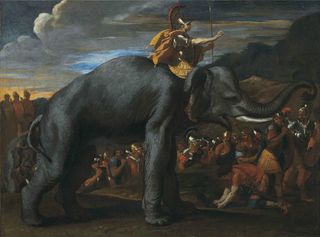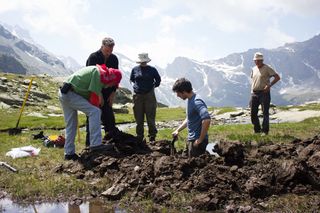Preserved Poop Points the Way to General Hannibal's Historic Path

The question of precisely where the historically acclaimed general Hannibal and his army crossed the Alps into Italy to defeat the Romans — during the Second Punic War, around 218 to 201 B.C. — has perplexed historians for nearly 2,000 years.
Thanks to a new study, the first evidence pointing to an answer has finally been unearthed. Clues to Hannibal's secret military route were recently discovered — not in maps or letters, but in the geologic record.
But it wasn't exactly rocks that revealed the full story. Scientists dug up signs of Hannibal's passage in preserved poop deposits, from a churned-up stretch of boggy terrain that likely served as a watering hole and toilet for the army's resting animals. [In Photos: Ancient Roman Fort Discovered]
Even the ancient Romans couldn't agree on where Hannibal's crossing took place, and scholars around the world have debated the topic over the thousands of years since. Some proposed that the general traced a route through a narrow mountain pass called Col de la Traversette, to the southwest of Turin, Italy, but they couldn't produce any archaeological proof.

Solid evidence
Chris Allen, of Queen's University Belfast, and William Mahaney, of York University in Toronto, were conducting research near Col de la Traversette that was unrelated to Hannibal. That's when the 2,000-year-old question about the general's Alps route confronted them in the shape of a mire, a waterlogged area along the mountain passage, Allen told Live Science.
It occurred to them that Hannibal's army — which included 30,000 troops, 37 elephants and an estimated 15,000 to 20,000 horses — would have needed to stop for water during their travels.
Sign up for the Live Science daily newsletter now
Get the world’s most fascinating discoveries delivered straight to your inbox.
And then, another colleague mentioned to Allen that when animals drink, they typically defecate.
"We realized if we were lucky enough in this mire to find a layer of sediment that was old enough and hadn't been disturbed, we might actually be able to find evidence of horse manure that would have been left by his army when they passed through," said Allen, an associate professor of environmental microbiology.
"A mass animal deposition"
The researchers excavated a cylindrical sample of soil called a core. They used carbon dating to establish that its layers dated back 8,000 years and examined changes — physical, chemical and microbial — that appeared in the dirt layers over time.
As they came close to the point in time when Hannibal was known to have crossed the Alps, unusual indicators appeared in the soil. The dirt was physically churned up, as though a number of animals had plodded through. Chemical analysis identified organic materials that typically inhabit a human's or a horse's gut, while DNA analysis revealed the presence of microbes associated with horse manure.
"By combining all these methods, we were able to point strongly to the fact that there was an accumulation of fecal materials at the correct date, about 2,200 years ago," Allen said. The quantity of dung appearing at that point in time hints at an animal presence that was unusual for the region, but was also likely to be associated with Hannibal, who was already known to be on the move across the Alps during that time, the authors suggested.
Mystery solved — not with a smoking gun, but with a once-steaming pile.
The findings were published online March 8 in the journal Archaeometry.
Follow Mindy Weisberger on Twitter and Google+. Follow us @livescience, Facebook & Google+. Original article on Live Science.

Mindy Weisberger is an editor at Scholastic and a former Live Science channel editor and senior writer. She has reported on general science, covering climate change, paleontology, biology and space. Mindy studied film at Columbia University; prior to Live Science she produced, wrote and directed media for the American Museum of Natural History in New York City. Her videos about dinosaurs, astrophysics, biodiversity and evolution appear in museums and science centers worldwide, earning awards such as the CINE Golden Eagle and the Communicator Award of Excellence. Her writing has also appeared in Scientific American, The Washington Post and How It Works Magazine. Her book "Rise of the Zombie Bugs: The Surprising Science of Parasitic Mind Control" will be published in spring 2025 by Johns Hopkins University Press.